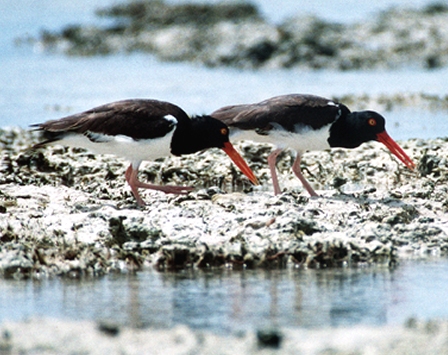|
American Oystercatcher Haematopus palliatus Ostrero Americano
|
 |
|
Photo: B. Hallett
|
|
IDENTIFICATION: A distinctive shorebird: dark brown and black above, and white below, with a bright, reddish-orange bill, and flesh-colored legs. In flight it has a contrasty, black and white wing pattern. Length: 40-44 cm.; weight: 400-700 g. VOICE: The call is a loud "kleep." Audio (M. Oberle). HABITAT: Restricted to rocky offshore islands near Puerto Rico, but elsewhere in its range it breeds on protected sandy beaches as well. HABITS: The Oystercatcher scrambles over rocks just above the waves, searching for molluscs, worms, crabs, and small fish. It has a very narrow, chisel-shaped bill that is specialized for opening molluscs. It often cuts the hinge muscles of a clam or mussel with surgical precision, and then pries the shell open. Sometimes the Oystercatcher cracks the edge of a mollusc and then uses that tiny opening to pry it off a rock. Favorite species in the Caribbean include whelks such as Cittarium pica. It can detect unseen prey by touch as it probes into crevices in rocks or shallow sand. Oystercatchers may establish a life-long pair bond. The pair may make several nest scrapes until finally settling on one to enhance with pebbles and shell fragments. Both sexes take turns incubating the two or three eggs for 27 days. Although the chicks are mobile right after hatching, they rely on both adults to feed them for the first two months---a very long period for a shorebird. In fact the chickís bill is incapable of manipulating mollusc shells for the first few weeks: the bill initially looks more like that of a plover. The chicks fledge about 35 days after hatching. In the non-breeding season, Oystercatchers sometimes roost with flocks of other shorebirds and terns. STATUS AND CONSERVATION: An uncommon, local species on rocky offshore islands and isolated beaches. Over most of its range it probably suffered from egg collecting a century ago, but now is more threatened by human disturbance at nesting sites. RANGE: Breeds locally from southern New England and Baja California south through Central America, and locally to Argentina and Chile. In Puerto Rico this species can be seen at rocky headlands or pebble beaches, e.g. Vieques, Culebra, Desecheo, and Cabezas de San Juan. TAXONOMY: CHARADRIIFORMES; HAEMATOPODIDAE. This species was formerly lumped with the Black Oystercatcher (Haematopus bachmani). |
